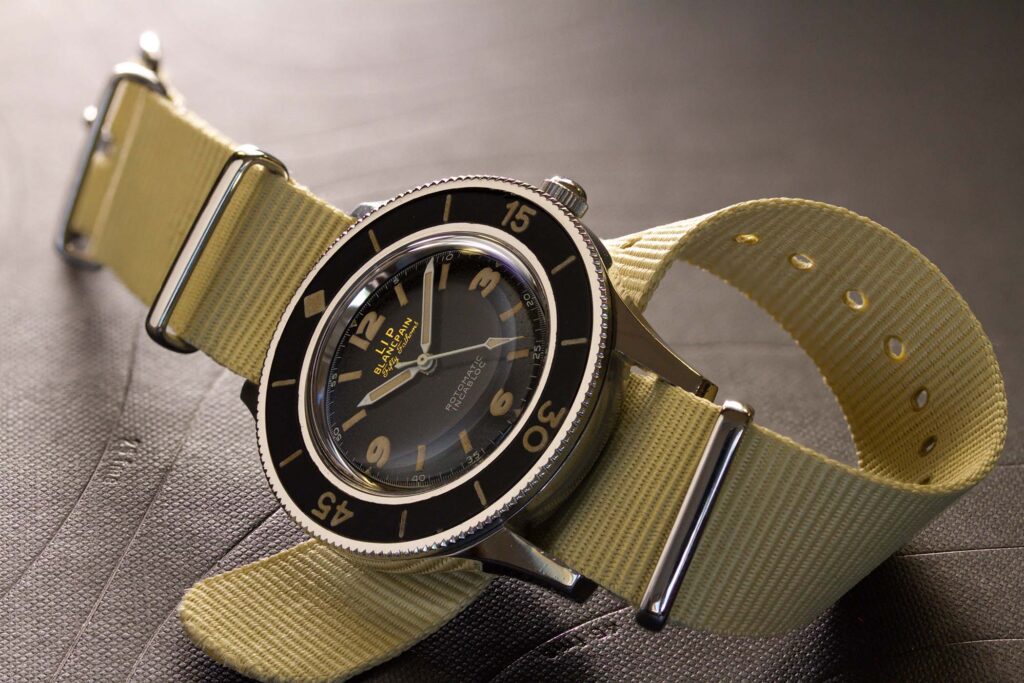Peter Speake-Marin is a name synonymous with horological artistry, innovation, and a unique perspective on the craftsmanship behind luxury timepieces. Renowned for his skill as a watchmaker and his candid, approachable demeanor, Peter has recently turned his expertise toward deconstructing watches to uncover the intricate details that make each timepiece extraordinary. His work offers an intimate view of horology, stripping away mystique to reveal the ingenuity and beauty within.
One of his most fascinating projects to date involves the Blancpain Fifty Fathoms, an iconic dive watch steeped in history and innovation. By deconstructing both an early model from the 1950s and a modern iteration, the Fifty Fathoms ref. 5015-1130-52, Peter bridges the gap between the past and present of this legendary watch. Let’s dive deeper into his work, the watches he explores, and why this process is so captivating.
Introduced in 1953, the Blancpain Fifty Fathoms was one of the first true dive watches, setting the standard for underwater timekeeping. It was developed in response to a request from the French navy, which needed a reliable tool for divers to measure their oxygen supply during missions. Jean-Jacques Fiechter, Blancpain’s then-CEO and an avid amateur diver, spearheaded the project. His personal passion for diving influenced the design, ensuring it met the rigorous demands of military use.
Key innovations of the Fifty Fathoms included a rotating bezel to measure dive time, luminous markers for visibility underwater, and a water-resistant case. Over the decades, the watch evolved, incorporating advanced materials and technologies while retaining its original spirit and functionality.
Peter Speake-Marin’s Deconstruction
Peter’s decision to deconstruct two Fifty Fathoms models—a vintage piece from the early 1950s and the modern ref. 5015-1130-52—offered a rare opportunity to study how this iconic design has developed over time. Here’s what makes his approach special:
Transparency and Accessibility
Peter’s deconstruction process is shared online, making high-end horology accessible to enthusiasts and newcomers alike. His videos and photographs break down the complex mechanisms of these watches, explaining their functions in clear, relatable terms.
Respect for Craftsmanship
While the deconstruction process involves physically dismantling the watches, Peter approaches each piece with reverence. His goal is not to critique but to celebrate the ingenuity and skill of the original watchmakers.
Comparative Insight
By analyzing the vintage and modern Fifty Fathoms side by side, Peter highlights both continuity and innovation in Blancpain’s approach. This comparison reveals how the brand has stayed true to its roots while embracing advancements in watchmaking.
The Vintage Fifty Fathoms
The 1950s Fifty Fathoms that Peter deconstructed is a marvel of early dive watch engineering. As one of the first models, it represents a significant milestone in horological history. Key features include:
•Rotating Bezel
A pioneering innovation at the time, the bezel allowed divers to track their oxygen supply easily. The tactile feedback and precise alignment of the bezel are hallmarks of thoughtful design.
•Luminous Markers
The watch’s radium-painted markers and hands ensured visibility in low-light underwater environments. While radium has since been replaced with safer materials, its inclusion in this model underscores the watch’s utility-driven design.
•Robust Case
With its sturdy, water-resistant construction, the vintage Fifty Fathoms was built to withstand the pressures of deep-sea exploration. Peter’s deconstruction revealed the meticulous sealing mechanisms that protected the movement.
The Modern Fifty Fathoms: Ref. 5015-1130-52
Fast-forward to today, and the Fifty Fathoms remains a benchmark for dive watches. The ref. 5015-1130-52 showcases how Blancpain has refined its design without compromising its heritage:
•Sapphire Crystal Bezel
Unlike the aluminum bezel of the vintage model, the modern Fifty Fathoms features a sapphire crystal insert. This not only enhances durability but also adds a touch of luxury, reflecting the watch’s dual role as a tool and a status symbol.
•Caliber 1315 Movement
The heart of the modern Fifty Fathoms is the in-house Caliber 1315, a robust and precise automatic movement with a 120-hour power reserve. Peter’s deconstruction highlights the movement’s intricate finishing and technical sophistication.
•Updated Materials
Advances in materials science have allowed Blancpain to enhance the watch’s performance. From anti-magnetic components to improved water resistance, the modern Fifty Fathoms is built to meet contemporary standards.
The Legacy of the Fifty Fathoms
Through his deconstruction, Peter underscores the enduring relevance of the Blancpain Fifty Fathoms. This watch is not merely a functional tool but a symbol of innovation and craftsmanship. Its design has inspired countless imitators and remains a touchstone for dive watch enthusiasts.
By comparing the vintage and modern models, Peter reveals a narrative of evolution and continuity. The Fifty Fathoms has adapted to changing times while preserving the core elements that made it a trailblazer. This balance of tradition and innovation is a hallmark of great design, and it’s what makes the Fifty Fathoms a timeless icon.
Why Deconstruction Matters
Peter Speake-Marin’s work is more than an exploration of watch mechanics; it’s a celebration of artistry. By taking apart these timepieces, he invites viewers to appreciate the skill and creativity that go into their creation. For many, watches are enigmatic objects, admired for their beauty but not fully understood. Peter’s deconstruction bridges this gap, fostering a deeper appreciation for horology.
Moreover, his comparative analysis of the Fifty Fathoms models serves as a reminder of the importance of heritage in design. It shows how a brand can honor its past while embracing the future, a lesson that resonates beyond the world of watches.
Impression
Peter Speake-Marin’s deconstruction of the Blancpain Fifty Fathoms offers a fascinating look at one of horology’s most iconic watches. From its groundbreaking origins in the 1950s to its modern incarnation, the Fifty Fathoms exemplifies the best of watchmaking: innovation, craftsmanship, and timeless design. Through his meticulous and accessible approach, Peter not only demystifies these masterpieces but also deepens our appreciation for the art of watchmaking. In doing so, he ensures that the legacy of the Fifty Fathoms—and horology itself—continues to inspire and captivate.
No comments yet.








